Japanese Design Archive Survey
DESIGN ARCHIVE
Designers & Creators
Kenzo Nakagawa
Graphic Designer, Creative Director
Interview: July 27, 2023, 15:00-17:00
Location: NDC Graphics
Interviewee: Shuichi Kanae, Azusa Tanaka(NDC Graphics)
Interviewer: Yasuko Seki
Author: Yasuko Seki
PROFILE
Profile
Kenzo Nakagawa
Graphic Designer, Creative Director
1947 Born in Osaka
1966 Graduated from Osaka Municipal Kogei High School, Department of Design,
Joined Takashimaya (Advertising Department)
1975 Joined Nippon Design Center
1979 Won the Tokyo ADC Award for a series of newspaper advertisements for Isetan
1980 Awarded Special Prize at the Brno Graphic Design Biennale
1986 Establishes General Graphics Laboratory as an in-house venture of NDC
1993 Establishes Xport
1994 Establishes NDC Graphics
2006 NDC Graphics head office relocates to Yokohama Bankokubashi SOKO
2017 Launched the Yokohama branding magazine “PeRRY”
2018 Awarded the 67th Yokohama Culture Prize
2019 Passed away
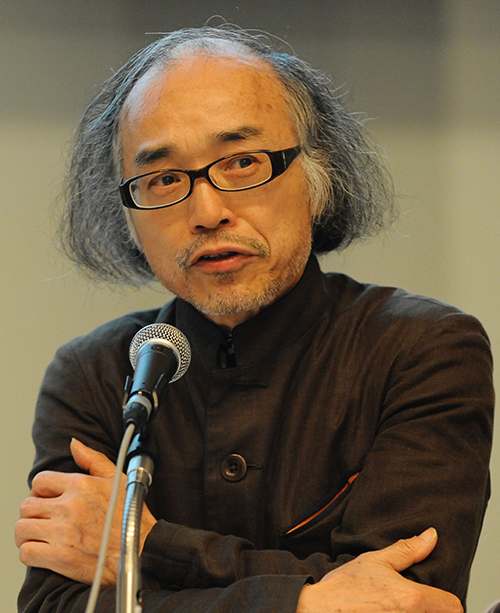
Description
Description
Kenzo Nakagawa must have been creating his designs while envisioning "a scenery with smiling faces”. Nakagawa's consistent philosophy of "design that makes life more enjoyable" is reflected in the numerous goods that allow visitors to fully enjoy the attractions of Yokohama, the diagrams and pictograms that serve as a universal language, and the infographics that accurately organize and reorganize information.
In the late 1980s, Mr Nakagawa was one of the first to incorporate computers into design and recognized the importance of "information design. At the same time, he insisted on familiarity, ease of understanding, human warmth, and playful expressions because this was an age when design was done in in the black box of a computer. There was a "story" conceived from Nakagawa's unique spirit of service. The packaging of the long-selling "Ginza Curry" was reminiscent of an old-fashioned Western-style restaurant in Ginza, while the map of Yokohama was designed to look like a page from a picture book.
Mr Nakagawa was particular about "whether the design had 'graphism' or not”. At a time when the majority of graphic design is being replaced by photography and digital expression, and many designs are cool but lacking in individuality, he was one of the few who pursued "graphism" as the orthodox form of original graphic design.
Mr Nakagawa was also one of the first to launch an in-house venture, the "General Design Center," which practiced design work by a team rather than a linear relationship of boss to staff, in other words, a networked work style involving people with diverse personalities. This eventually grew into a dual-role system of "NDC Graphics" for design production and "Xport" for merchandise development and sales, and developed into community design that connects people and things, people and people, people and places, people and information, and people and affair.
He is an "uncrowned designer" in terms of the quality and quantity of his work. He himself seems to have been indifferent to design awards and the like. However, Nakagawa's design genes are scattered throughout NDC Graphics, Xport, and Yokohama, and will be steadily passed down from generation to generation.
For this interview, we spoke with Shuichi Kanae and Azusa Tanaka of NDC Graphics, who are responsible for the inheritance and development of this design gene.
Masterpiece
Masterpiece
‘Marble chocolate’, Meiji (1988)
CI design for ‘Kobe Croquette’, Rockfield (1989)
‘Three O'Clock’ Meiji (1989)
‘Yokohama Landmark Tower’, construction site temporary enclosure,
Mitsubishi Estate (1991)
‘Graphics News series’, Kyodo News (1991-93).
Out-of-print nautical chart series, Xport (1993-)
Branding for ‘Ginza Curry’ series, Meiji (1994-)
Pictograms: ‘Symbols for Standard Guide Map’, Ministry of Land, Infrastructure, Transport and Tourism / Foundation for Transport, Ecology and Mobility (2001).
Jointly: Japan Sign Design Association
Original goods for NYK Maritime Museum , NYK Maritime Museum(2001-)
Yokohama city pedestrian guide map, Yokohama City (2002)
‘Three Towers Graphics’ for The Osanbashi Yokohama International Passenger Terminal, Yokohama City (2002)
‘BlueDal Project’, Minato Mirai Line City Center Revitalisation Liaison Council (2004)
Renewal design of the paper of “Kanagawa Shimbun”, Kanagawa Shimbun (2004)
Pictogram for Aichi Expo 2005, Japan Association for the 2005 International Exposition, Japan (2005)
Wall graphics for Yokohama City Waterworks Bureau, Kojaku No. 6 drainage, Yokohama City Waterworks Bureau (2007)
Yokohama Bay City traffic map, Yokohama City (2007)
Symbol mark of the Japan Tourism Agency, Japan Tourism Agency (2008)
Design of “Monthly Reports” published by Nissey, NIL Research Institute (2008-)
Planning, management and design of ‘Polish Poster Exhibition’, Polish Poster Exhibition Committee(2012)
Development of the official shop and goods for the Exhibition of ‘Japanese National Treasures’, Tokyo National Museum (2014)
Illustration: Kazumasa Nagai
Editor and Art Director of “PeRRY”, Yokohama Machizukuri Club (2017)
Graphic design of bus wrapping of Yokohama, Yokohama City (2018, 2019)
Publications
“Graphic Saijikki (Graphic Chronicles)”, Kouga Communication Products (1994).
“The Latest Computer Design" Jikkyo Shuppan (2006)
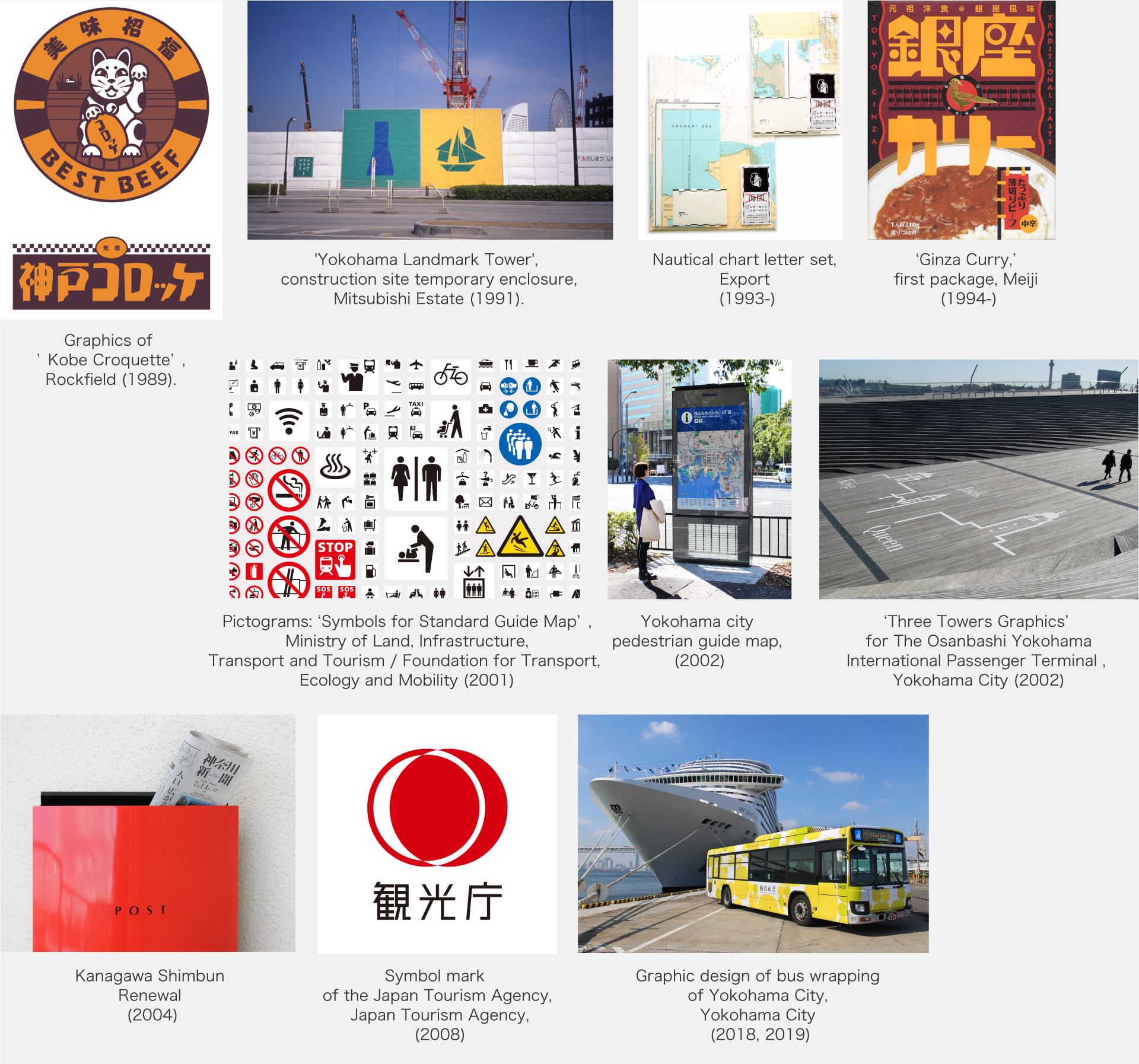
Interview
Interview
The mission of design is to create memorable new scenery....
Through practical work, we want to preserve and pass on Mr Nakagawa's design.
Design and business succession
ー I was very surprised to learn about that Kenzo Nakagawa passed away in 2019 at the age of 72.
How did you take over his work?
Kanae Mr Nakagawa insisted on designing as a team. When he was scouted by Kazumasa Nagai and moved from Takashimaya to Nippon Design Center, he did not want to work alone, but as part of a team that included Hiroyasu Nobuyama and Satoru Morikami. The way of working was mainly team and group work, and at NDC Graphics (hereafter NDCG) he was also designing in the capacity of producer and art director. Therefore, his death was of course a great blow, but his ideas and designs certainly sunk in for all of us.
ー I understand that Mr Nagai scouted Mr Nakagawa, what prompted him to do so?
Kanae Mr Nakagawa was not satisfied with just working at Takashimaya, so he formed a group called 'Bolt Nuts Studio' with Mr Nobuyama and Mr Morikami and was doing his own creative work. Their designs were introduced in the magazine ”Idea”. I heard that Mr Nagai saw this and approached Mr Nakagawa. Nippon Design Center was an organised design company founded with the aim of improving design in Japan, which suited him.
Tanaka In her day-to-day work at NDCG, Mr Nakagawa was the design director, bringing ideas and direction to the project and organising it. He said that he was not worried about design, as he had nurtured it by sharing his work and experience with Kanae and the staff.
ー NDCG worked on a team system, so you were able to pass on his designs in a natural way.
Kanae I am in charge of sales and management, so in terms of management, I manage somehow. However, Mr Nakagawa also founded a Yokohama-based goods development and sales company called 'Xport', of which he was also the president. This is a manufacturing and distribution company, so there are different difficulties from the design company in terms of management.
Tanaka There are designers who have produced original products as stand-alone items. However, I don't think there are any examples of designers like Mr Nakagawa who have planned, designed, manufactured and even created a shop for their products. And for sustainable management, we can't just commercialise what we like blindly. We have to clear up a huge amount of work, from how to produce efficiently and continuously, to costing and production system development.
Kanae Mr Nakagawa was in and out of hospital several times over the past 10 years, each time returning with miraculous resilience and full of energy. Under these circumstances, he must have taken time to think about the future of NDCG and Xport. One day, while he was in hospital, he called me up and asked me to be the president of Xport. To be honest, I was worried, but I accepted and here we are today.
Tanaka Mr Nakagawa handed over the presidency of Xport to Kanae, who died while still president of NDCG.
ー What is the current status of the works and materials related to Mr Nakagawa?
Kanae Here (on the first floor of the Yokohama Silk Center) is the office and shop for NDCG and Xport, but we have rented another space on the sixth floor in this building, part of which is used as storage for artworks and materials.
We have kept his works, but most of the materials related to the design process, such as sketches and block prints, were disposed of when we moved from Bankokubashi SOKO to the Silk Center in 2021. The old prints and other materials had to be destroyed because the glue had peeled off. However, the Nippon Design Center also has examples of the work in storage, and I have heard that they have been digitised.
Tanaka Mr Nakagawa has been practising digitisation of design by incorporating computers since the late 1980s, so fortunately many of his works and design processes remain as digital data.
ー Do you mean that you had organised your works and materials, including digital data, before?
Kanae Each person in charge organised them. However, in the case of computers, when the operating system changes, the data cannot be opened. For this reason, very few of his documents, texts, sketches and notes remain. What survives are his works, digital data, photographs and his library. One thing that is typical of Mr Nakagawa is a commemorative photograph taken once a year of all the members of NDCG and Xport, which has been made into an album.
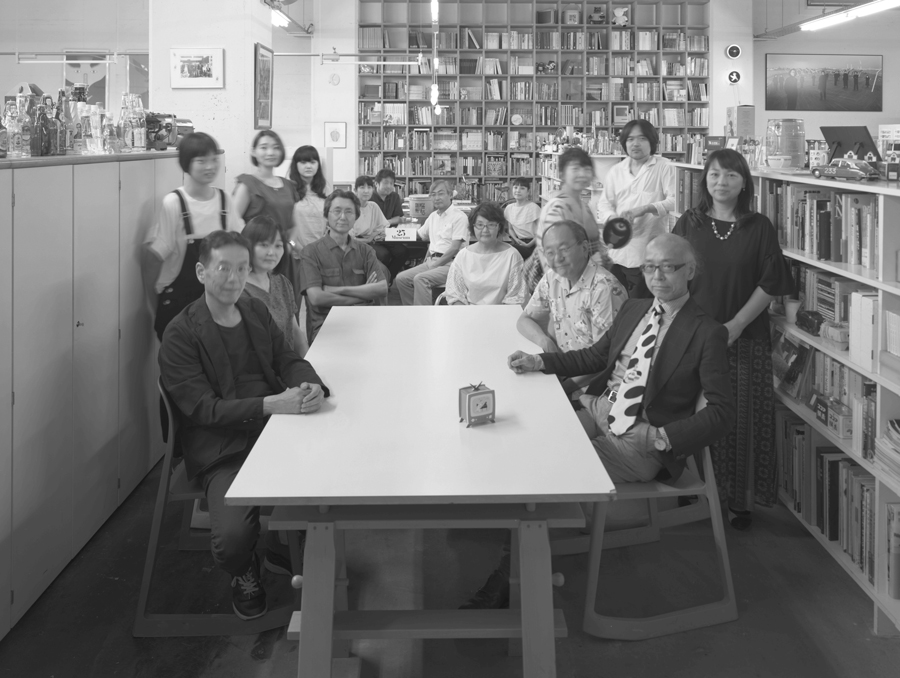
Commemorative photo of all members, 2018, at Bankokubashi SOKO.
Tanaka There was a large collection of books, but we sorted and narrowed it down to half when we moved.
ー Do the artworks include Xport’s products?
Kanae Xport’s products are equal to his work. All the products that are still being manufactured, samples, etc. are also included. As far as food products are concerned, the packaging and bottles are kept as works of art.
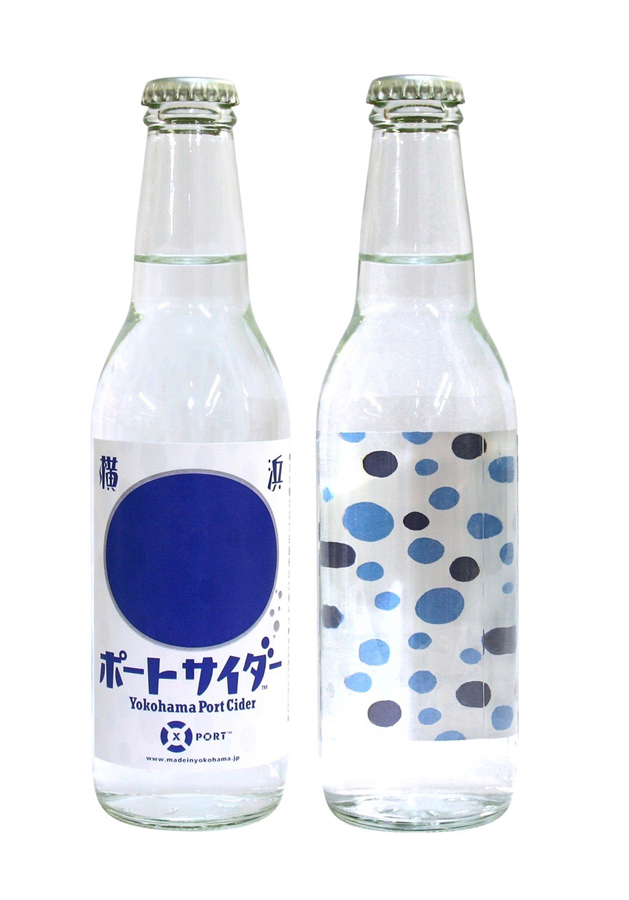
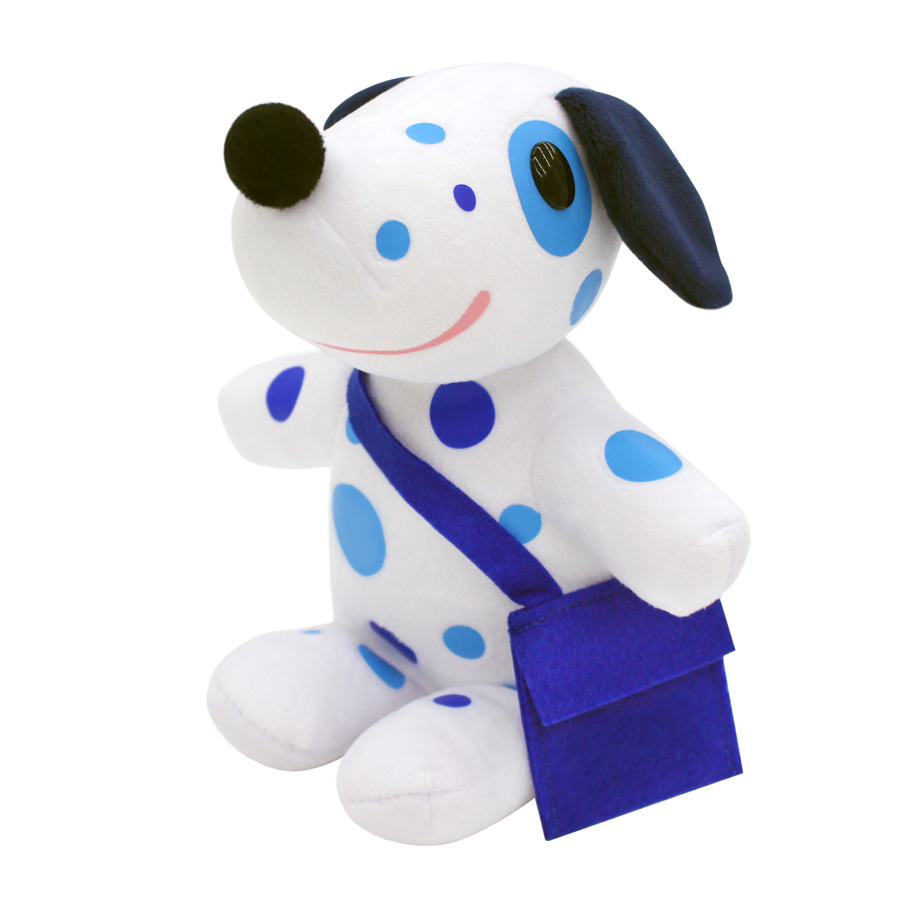
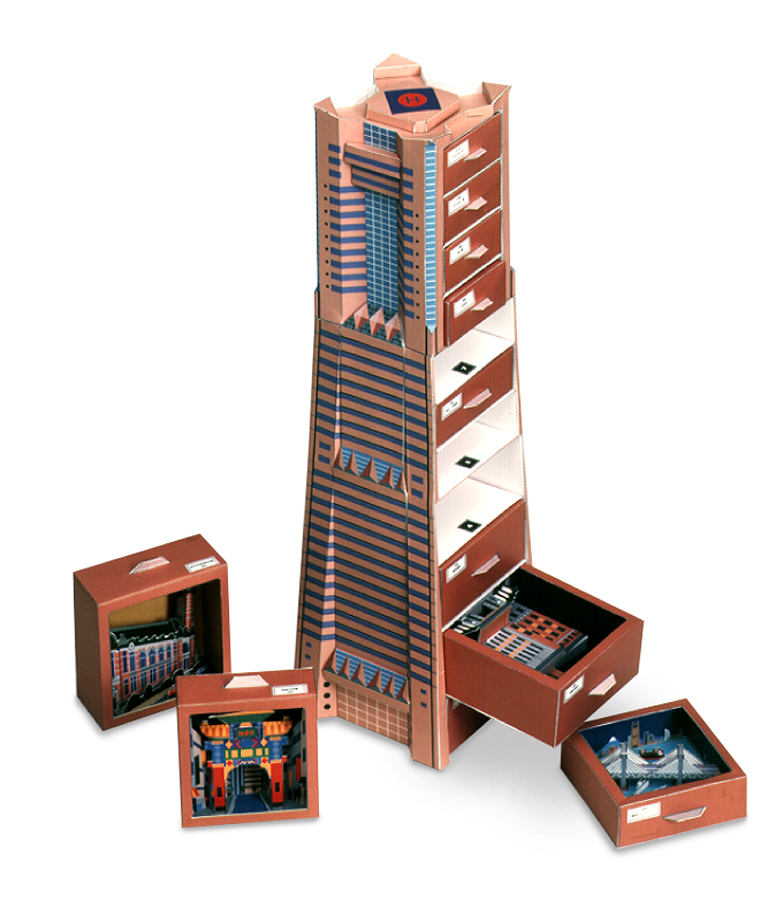
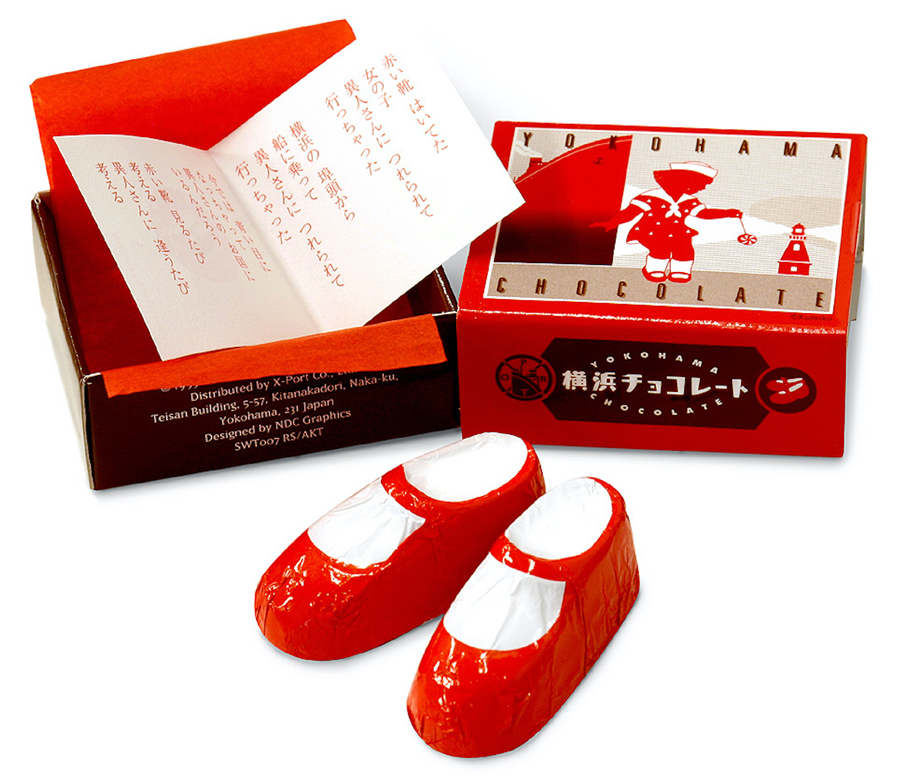
Xport products "Yokohama Port Cider", "BlueDal Stuffed Toy", "Tower Cabinet", "Yokohama Chocolate".
ー I remember that Mr Nakagawa loved and collected goods from the East and West, but what about his personal collection?
Kanae Some items were brought back by his family, but the goods on display here are from his collection. He always said, "I have a mixture of public and private life".
ー How about the collection and donation of his artworks to museums and universities?
Tanaka Mr Nakagawa was not an art-oriented designer, but focused on 'design in daily life'. he made a clear distinction between 'art' and 'design'. So, although he would have been happy to have his works collected by a museum, he did not work on his own or design with the aim of having them collected.
Kanae He was a team-oriented person, so he did not want his work to be collected by the museum under his name. However, we would like to preserve and pass on Mr Nakagawa's designs through actual work.
Working from two bases, Ginza and Yokohama.
ー From here we would like to talk about Ms Nakagawa as a creator. After graduating from the design department of high school, he worked as a designer in the advertising department of the Takashimaya Sakai shop. 1975, he was scouted by Mr Nagai and transferred to Nippon Design Center, where he established the General Graphics Laboratory as an in-house venture in 1986, which led to NDCG. Can you tell us how that led to NDCG?
Kanae I joined Nippon Design Center in 1984, working in a different department to Mr Nakagawa, and while watching how he worked, I had the impression that he and I were opposites, water and oil.
Ten years after that Mr Nakagawa moved to Nippon Design Center, where he was in charge of design for Isetan, he began to think that he wanted to review his routing work and client relationships and find his potential as a designer. At that time, Nippon Design Center had a dedicated team for each client to handle design work. He had doubts about such a situation.
And this is where Mr Nakagawa's true spirit comes in: he put together an ideal organisation in which designers take the lead in realising comprehensive design, from advertising to the environment, and presented it to the then Chairman Matsuo Suzuki. Chairman Suzuki was a strict man, but he said, "If you insist, go ahead and do it, but find your own clients", and a laboratory-style in-house venture called the " General Graphics Laboratory " was born. This was the first attempt for Nippon Design Center. At that time, I was transferred from another department to work in the same team with him.
Today, Nippon Design Center has a three-tier structure - the Administration Division, the Production Division and the Production and Research Division, like the Hara Design Institute - but I think Mr Nakagawa pioneered this.
ー Then you went independent as a separate company from your in-house venture?
Kanae With the increase in work in Yokohama, we became independent as 'NDC Graphics' in 1994. However, Nippon Design Center invested half of the capital, and Mr Nagai still takes on the role of advisor. Xport was also established at the same time.
ー It was in the early 1990s that Mr Nakagawa also opened an office in Yokohama, wasn't it?
Kanae Yes. It all started when he participated in an urban design tour of Yokohama City through an acquaintance. At that time, he met a person in charge of the Mitsubishi Estate, which was developing 'Minato Mirai 21', and was asked to do graphics for the temporary enclosure of the Yokohama Landmark Tower construction site, which was under construction. This led to NDCG being commissioned to produce a number of other projects, including guide maps and traffic maps for the central Yokohama area, signs and pictograms for public facilities such as The Osanbashi Yokohama International Passenger Terminal, the BlueDal Project, graphics related to forums and events held in Yokohama, logos and marks for local companies and facilities, and the redesign of the Kanagawa Shimbun, etc.
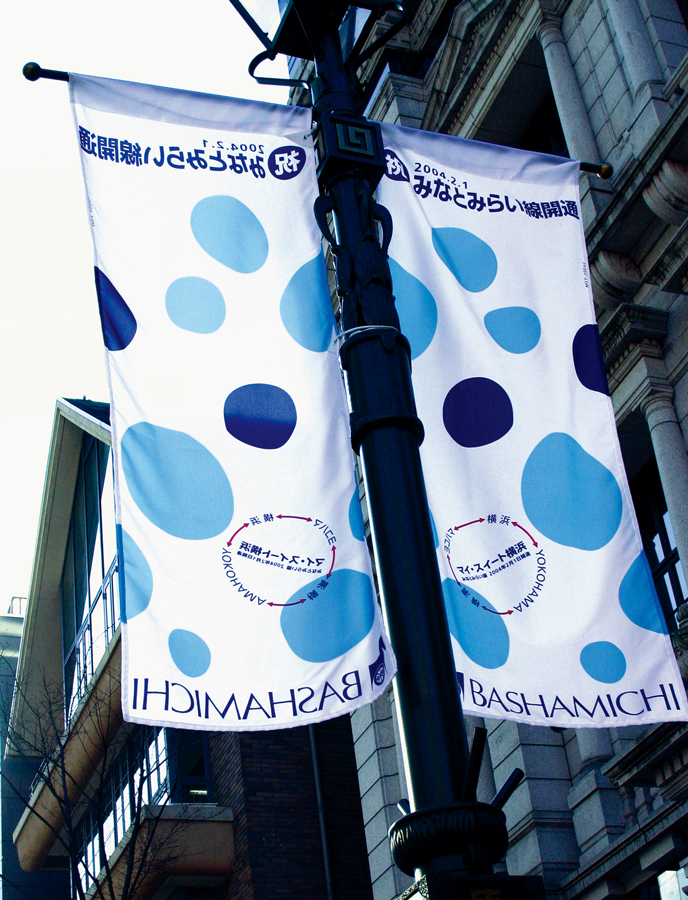
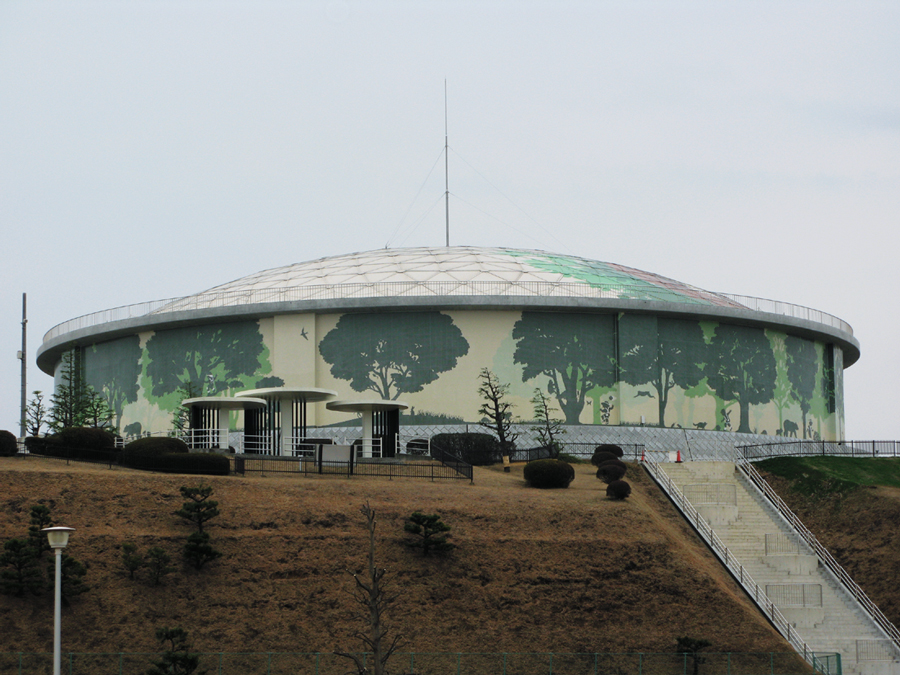
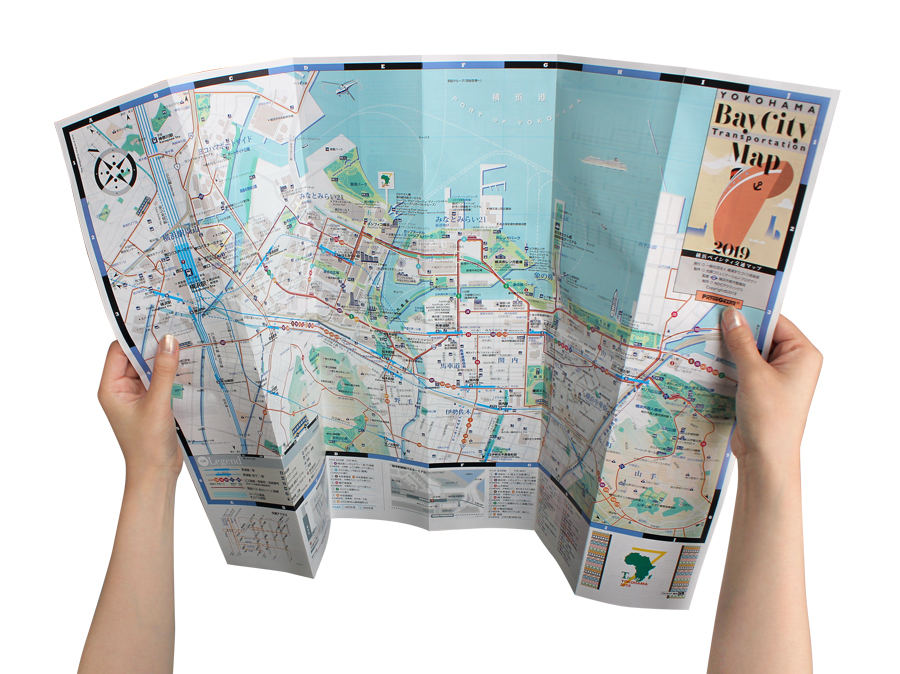
Various Yokohama designs, including the Minato Mirai Line opening flag, drainage pond wall graphics, traffic maps.
ー The company was not just about design, but also about establishing a company called Xport with the aim of being a "shipping port for Yokohama goods", which is an amazing idea by Mr Nakagawa.
Kanae The idea for Xport came from Mr Nakagawa's typical service spirit: "Since you have come all the way to Yokohama, we want you to take your memories home with you". Initially, there was a shop called ’Tower Shop’ on the fifth floor and 69th floor of the Yokohama Landmark Tower.
ー Wasn't it difficult to manage Xport after three years of the Corona disaster?
Kanae That is correct. The world was drastically changed by the Corona disaster starting in the spring of 2020, six months after Mr. Nakagawa passed away. Xport suffered a devastating blow, but we persevered for three years and finally returned to profitability this spring.
ー I think of Mr Nakagawa and Yokohama design, the creation and development of the character "BlueDal" is also impressive.
Kanae When the Minato-Mirai Line opened in 2004, a project to "enliven Yokohama" was launched and Mr Nakagawa became the design director. He came up with the idea of a welcome flag often seen overseas, the design image of which was blue dots. But just dots are boring, so he tried to make the dots of the Dalmatian dog in the photo blue, and the result was surprisingly interesting. Thus was born the fascinating character BlueDal. The fast-footed Dalmatian dog is used in Europe and the United States as a lead dog for fire trucks, and was a perfect fit for the Minato-Mirai Line opening campaign. Since then, BlueDal has appeared in various places in Yokohama to serve as a guide, and Blue Dot has been used in various ways as a symbolic design motif for Yokohama.

From the dotted BMWmini displayed at the Yokohama Takashimaya Department Store to other, BlueDull has appeared all over Yokohama.
ー Blue is now recognized as Yokohama's city color. He has contributed to the design of Yokohama's image.
Kanae After that, Mr Nakagawa became involved in community design in Yokohama. As a member of the "Yokohama City Planning Club" established in 2009, he organized picnics and other events, served as editor of the Yokohama cultural magazine "PeRRY," and in 2012 became a member of the organizing committee for an international exhibition "Polish Posters Exhibition".
ー I thought it was really bold of you to move the axis of your activities from Ginza to Yokohama.
Kanae Initially, when we were in the Teisan Building in Yokohama, we were positioned as a satellite studio, and our main base was in Ginza. The entire base was moved to Yokohama in 2006 when we moved to Bankokubashi SOKO, and the Yokohama and Ginza teams became one, and I moved from Ginza at that time. Mr Nakagawa's network in Yokohama expanded and he became involved in urban and community design, he came to understand and deeply love the inherent magnetism of this city.
In this sense, we were very pleased that he reived the "the 67th Yokohama Culture Award" in 2018. Because this award is not limited to designers, but anyone who has contributed to the enhancement of Yokohama's culture is eligible to receive it. He decided to hold a celebration party on February 1, 2019, and worked hard to prepare for it. After the party, he came to the office to organize a huge amount of documents, and was interviewed on June 11, and five days later, he was hospitalized and passed away.
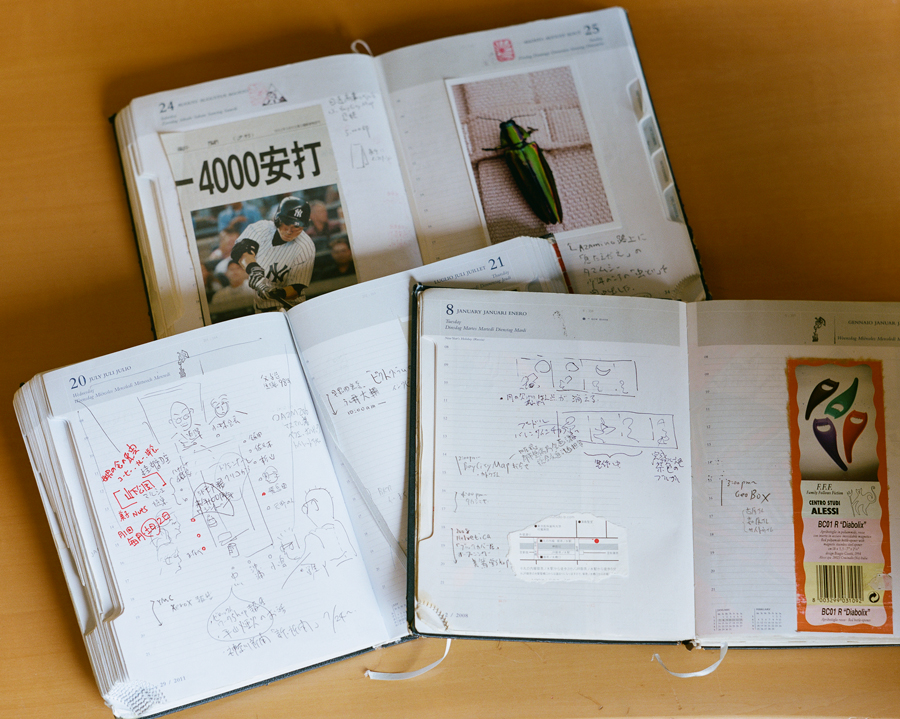
Schedulebook with design ideas written in letters, photographs, and sketches (from the memorial issue of "PeRRY" Kenzo Nakagawa)
Designer with a journalist's mindset
ー In the late 1980s, shortly after computers were first used in design, Mr Nakagawa began advocating "information design" and "infographics" to convey numerical and textual information in an easy-to-understand manner through graphics. The ability to "think ahead" is essential for designers, but how did he acquire this foresight and ability to execute?
Tanaka Nakagawa's roots as a designer can be traced back to the "school newspaper" he independently produced when he was in his first year of junior high school. He became the director of the newspaper, which had once been discontinued, and put it together by assigning different roles to different people, such as those who wrote articles, those who did the layout, and those who were in charge of printing. Through this experience, he realized that he was suited to planning something fun, thinking of roles, and leading the whole project. While many people become designers because they are good at drawing or like crafts, he was different. Even in the field, he focused on finding social issues, analyzing their essence, and deducing solutions.
Kanae I have heard that he wanted to be either a journalist or a detective If he wasn't a designer, so I think his design inspiration was journalistic. “Infographics" is also a way of making things that are difficult to understand in numbers or text easier to understand through graphic design. For example, starting in 1991, he collaborated with Masanobu Kuryu of Kyodo News to produce a variety of data as "Graphics News," a new type of "news article to watch," for three years. Later, he compiled them into a book titled "Graphics Chronicles" (published by Koga Communication Products Co). In the book, Mr Nakagawa wrote, "It is not text, it is not a photograph, it is a third type of information--a 'news to see' article using graph fixes". I think this was a viewpoint that anticipated the era of accelerating information technology with the spread of computers in the early 1990s.
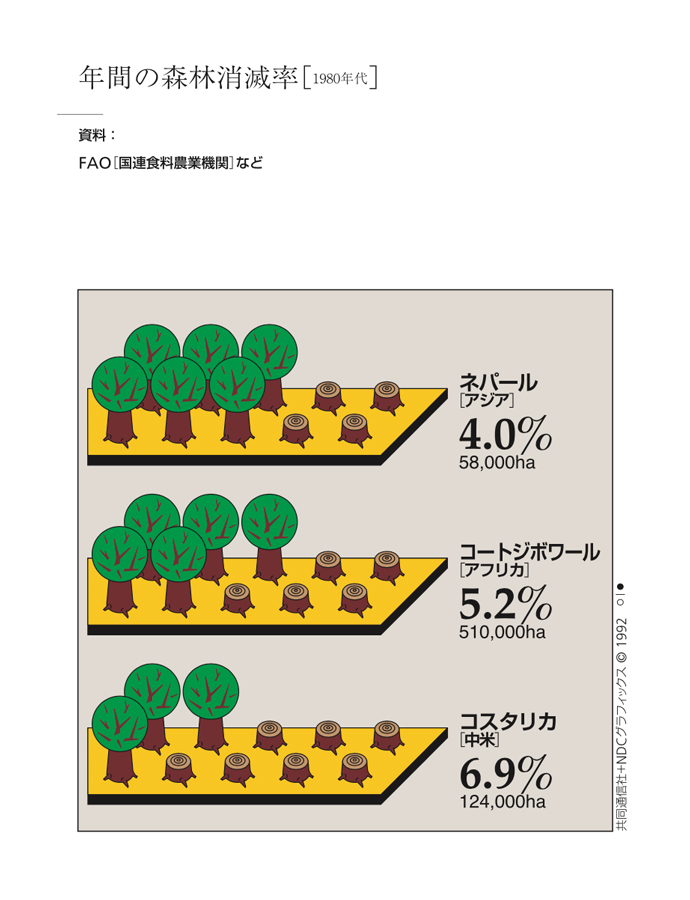
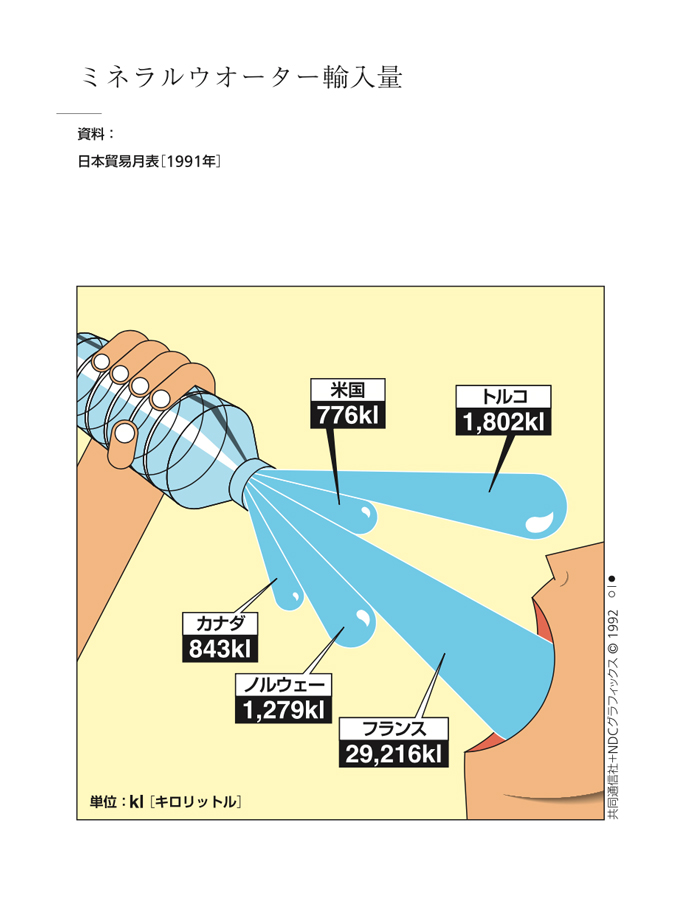
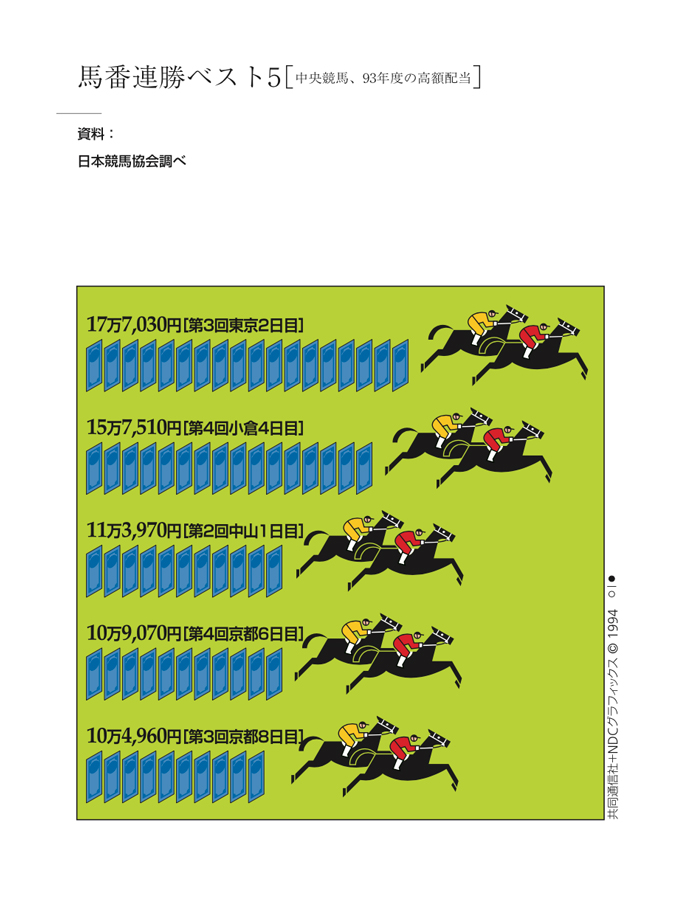
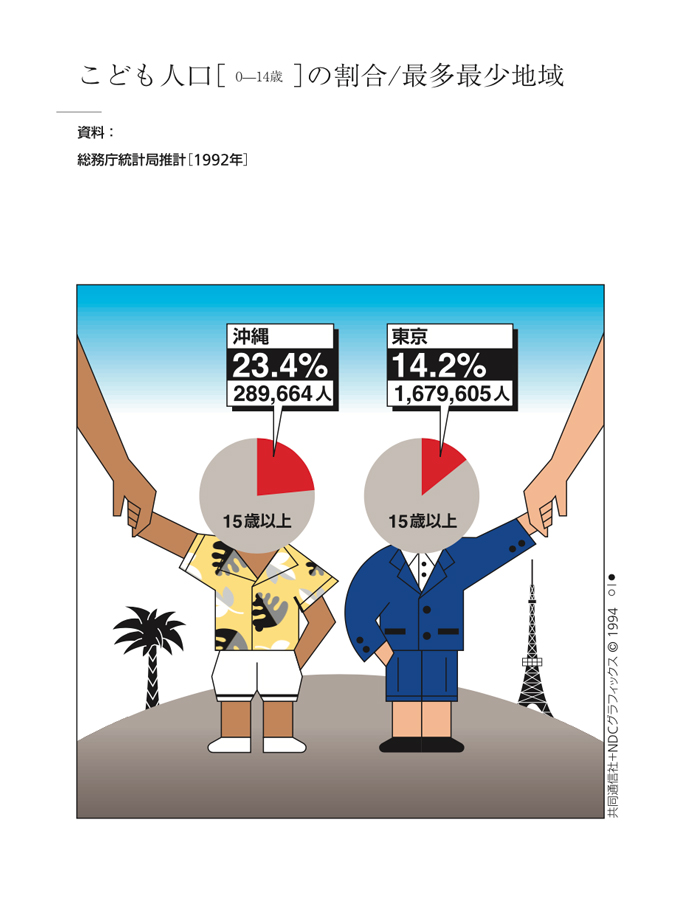
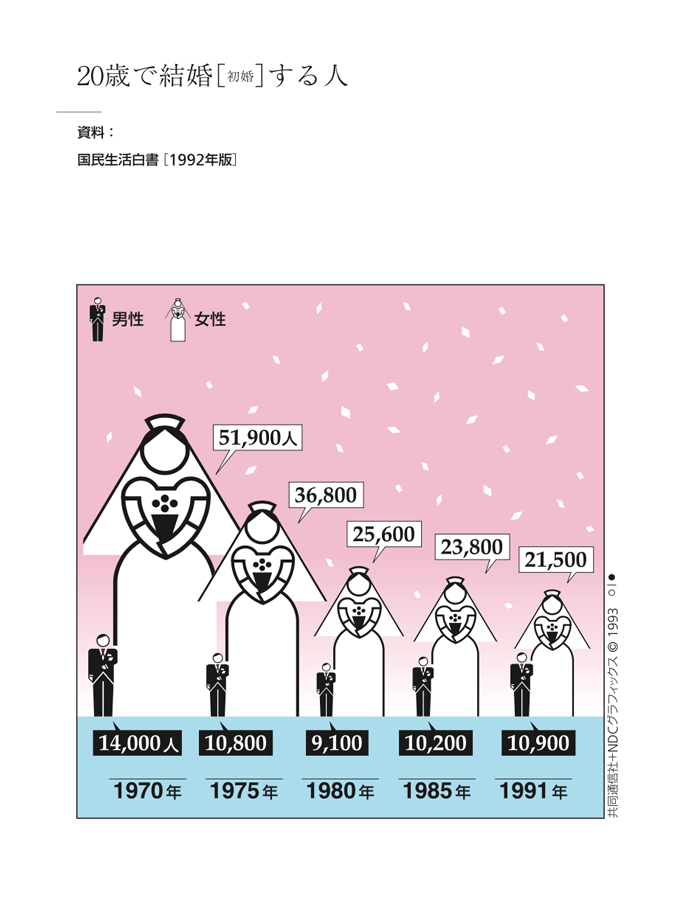
"Graphics News:" which was serialized in Kyodo News and later compiled into a book.
ー And even today, visualizing various data of society and expressing them in diagrams and pictograms is an area in which NDCG excels, isn't it?
Kanae In a magazine interview, Mr Nakagawa said this about information design: "From now on, I think we need 'graphists,' not journalists" (+DESIGNING, November 2009). He continued, "It is essential to have information Designers = Graffists who convey information clearly and accurately". Whether pictograms or diagrams, infographics is a global and universal language that anyone can understand. Designing difficult things in an easy-to-understand and beautiful way was his most important creed.
ー I think the development of goods using discarded nautical charts was pioneered by SDGS.
Tanaka That was around 1993. He first encountered nautical charts when he visited the Japan Coast Guard during a project in Yokohama. However, I heard that nautical charts are updated every year and that the out-of-date editions are disposed of as industrial waste for a fee. He then immediately said, "If you're going to throw them away, I'd rather you give them to me. Thus, letter sets and paper bags made from recycled nautical charts were created, and the series of out-of-print nautical charts is still a popular Xport product with an increasing number of items.
Kanae “The nautical charts are beautiful, aren't they? Do you want to throw this away? What a waste. Then give it to me”.
Mr Nakagawa's ability to think, act, and intuitively make this statement on the spur of the moment was also outstanding.
Tanaka That's an idea from the field. He said, "It is important not only to think about everything on the desk, but also to visit the site".
ー So the design targets were all the things in our daily lives.
Kanae That's right. More specifically, "design for a pleasant lifestyle" and "for an enjoyable life”. This is no different today at NDCG. He separated art and design. Art raises issues, while design solves problems, and they have different starting points. His stance was to discover and delve into the various problems and issues in society and solve them through the method of design.
About future
ー Please tell us what you think was great about Mr Nakagawa.
Tanaka For me, it was the fact that he never just standed up. When he was discharged from the hospital, to his surprise, he got a job at the hospital. It was graphics for the hospital's huge atrium space.
Kanae After that, we also worked on the signage plan for the hospital.
ー It was amazing. It's true that he won't just get up. What was the trigger?
Tanaka I heard that he told the nurse in charge, "The hospital's signage plan was a mess and hard to understand, which was why there are so many signs all over the place". The doctor who heard this story approached him for a consultation, and the conversation proceeded without a hitch. While most people would be occupied with treatment, he was thinking about the design of the hospital. ...... I was impressed by his thoughtfulness.
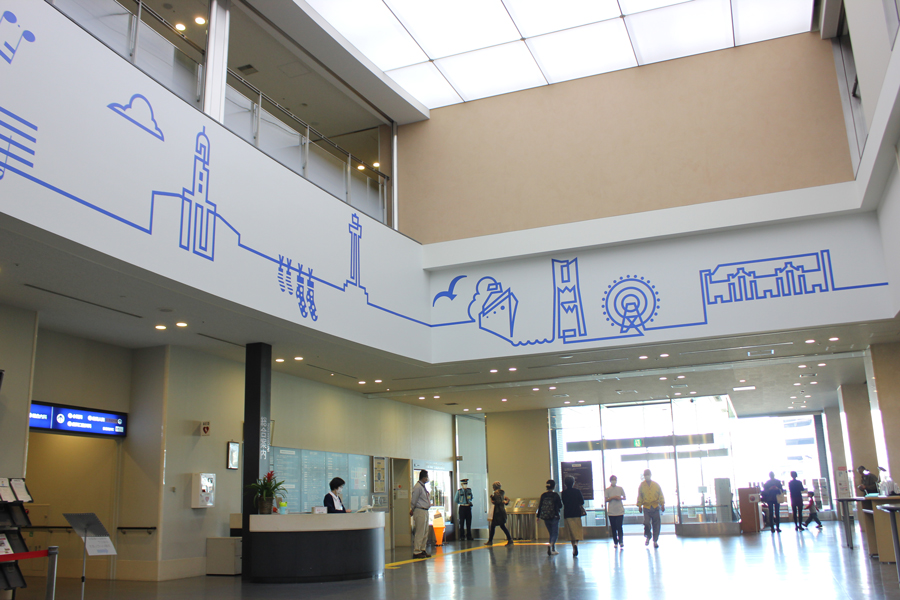
Graphic of the atrium
Kanae The power of Mr Nakagawa to take everything he saw and experienced and outputted it as better design was truly amazing. And he was a man who kept the purity of a child.
ー I can see the situation.
Kanae Then there was his presentation skills. At a time when AIDS was a social problem, we were consulted by Kanagawa Prefecture on a promotion to raise awareness of AIDS. At the presentation, he suddenly shook hands with the important people of Kanagawa Prefecture. He then said, "Now I shook hands with you all, but it's okay, isn't it?" and presented a design proposal that represented "hands shaking hands”. His intention was to "eliminate prejudice against AIDS”. Thanks to his bold presentation, our proposal passed. His own thoughts and purity are innate and difficult for others to inherit. He prepared his presentations by anticipating his opponents. However, he had a strong will to decide on what he wanted to do and his batting average was high.
Tanaka Mr Nakagawa was able to act freely and boldly because Kanae and the staff were standing firmly behind him, and I think that trust was a big factor.
ー Lastly, please tell us about your future plans.
Kanae I would like to talk from a management perspective. Xport was finally able to return to profitability this spring, and I would like to maintain and develop it as it is. NDCG has not suffered any major damage under Corona, and I think it is important to train young employees while introducing new ways of working, such as telecommuting. To this end, we want to build a solid foundation while we pass on his spirit and designs. Corona has brought us a major change in thinking to us. We used to work from 9:00 to 22:00 as a matter of course, but now it is more natural to enjoy life.
Tanaka However, Mr Nakagawa was a man of "mixed public and private life," so his current situation may be a little sad (laughs).
ー NDCG's design is characterized by "graphics," as the company name implies. It seems that the original graphics such as typography and diagrams are fading away in recent graphic design. Against this backdrop, NDCG's attention to graphics, handmade feel, and slightly nostalgic retro feel are refreshing.
Kanae Mr Nakagawa was particular about whether the design had "graphism" or not. In terms of the retro feel, in an interview published in the Keikyu Group's magazine "Nagisa" published in August 2019 after Nakagawa passed away, he said, "What I value in Yokohama design is to incorporate the memory of the building and the area. If you make something properly, the older it gets, the more it tastes and remains for 100 years. The role of design is to create new scenery that will be remembered" (partially edited).
ー Many design firms dissolve when the boss passes away. From the viewpoint of archiving, I think the most powerful thing is for the company to survive and for the deceased boss's designs to be handed down to the next generation in a living form.
Kanae In ordinary design offices, there is a boss, staff, and administrative staff, but since we have two companies, NDCG and Xport, we can continue Nakagawa's will while taking advantage of not only design work but also a wide range of human resources, activity possibilities, and network of client.
ー Thank you very much for your time today.
Location of Kenzo Nakagawa's archives
For inquiries, please contact
NDC Graphics, Inc.
http://ndc-graphics.jp/

